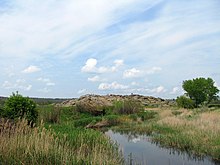Wild field
Wild Fields , also Wild fields or Desht-i-Kiptchak ( Russian Дикое поле , Dikoje pole ; Ukrainian Дике Поле , Dyke poles , polish Dzikie Pola , lat. Loca Deserta , sive Campi deserti inhabitati) was a since the era of the Rus to Term used in the 18th century for the steppe landscape of today's southern and eastern Ukraine , also called Pontokaspis . Due to the lack of geographical barriers, this extension of the great Eurasian steppe enabled high mobility and has always been a transit area for numerous equestrian peoples and nomads migrating from east to west . For a long time, the northern border of the Wild Field to the forest landscape of Eastern Europe also formed the border between nomadic and sedentary civilizations . Although the areas of the Wild Field were very fertile due to the high concentration of black earth, they were undeveloped for agricultural use for a long time due to the constant threats and attacks of the equestrian nomads and were sparsely populated until modern times.
history
The open landscapes of the Wild Field were inhabited by the Scythians and Sarmatians in antiquity , who left behind numerous Kurgane , burial sites and large stone figures. During the time of the Great Migration , peoples such as the Huns , Avars , Bulgarians and Magyars used the wild field for incursions or migrations to the west. In the 8th and 9th centuries East Slavic tribes Tiwerzen and Ulitschen temporarily settled the areas between Prut and Dnepr , but were displaced by the Turkic Pechenegs in the 10th century . The Rus used the Dnepr as part of the route from the Varangians to the Greeks for campaigns and trade with Byzantium and had to cross the dangerous steppe landscapes for this. For example, Grand Duke Svyatoslav I was ambushed by the Pechenegs on his return from the Balkans in 972 and was killed. After the Pechenegs were beaten and driven out, they were replaced by the Cumans (Polovzians) who plagued the Kievan Rus for another 150 years.
The Mongols also initially came from the Wild Field and defeated a Russian force in the Battle of the Kalka in 1223 near what is now Donetsk . With the Mongol invasion, many Slavic cities and settlements were destroyed again, which over time had advanced further and further into the fertile wilderness. For a long time, the area belonged to the Golden Horde , who continued to use the open landscapes for raids and attacks on Russian cities, which were now under the Grand Duchy of Lithuania . The Crimean Khanate emerged as a splinter state of the Golden Horde , which together with the Nogaier Horde ruled large parts of the steppe and undertook regular raids against the Moldova , Polish-Lithuanian Ukraine and Moscow and Russia , during which many slaves were captured.
Although the wild field was very dangerous because of the (Crimean) Tatar threat, it also offered freedom for the East Slav peasants who wanted to escape the feudal pressure of the Polish-Lithuanian aristocratic republic or the tsarist empire. They founded communities of the Cossacks as defensive farmers and led a semi-legal existence as robbers, but also as protectors of the Ukraine against the Crimean Tatars . The country south of the Dnepr rapids was called Zaporozhye (literally: behind the rapids) and gave its name to the Zaporozhian Cossacks , who built their center here, the Zaporozhian Sitsch . This is where the resistance to Polish supremacy over the Ukraine began again and again and culminated in the great Khmelnytskyi uprising in 1648 . As a result of the alliance with Russia , Ukraine east of the Dnieper came under the rule of the tsar for a long time.
Even if the Slavic civilization slowly advanced south, for example with the permanent settlement of Sloboda-Ukraine , it took over a hundred years until the khanate of Crimea was separated from the Ottoman Empire during the Russo-Turkish War of 1768–1774 and a short time later was annexed by the Russian Empire . The elimination of the Tatar danger enabled, under the direction of Prince Grigori Potemkin, a broad-based development and settlement program for the newly acquired areas called New Russia . At the end of the 18th century, numerous cities were founded, which made the term wild field obsolete. Among them were such cities as Yelisavetgrad , Kherson , Nikolayev , Yekaterinoslav , Odessa and others. Farmers from Serbia (see New Serbia ) and Germany (see Black Sea Germans ) , among others, were attracted to colonize the fertile areas . The wild field was mainly populated by Ukrainians and Russians , which means that these areas are culturally close to Russia to this day.
Individual evidence
- ^ Włodzimierz Wilczyński: Ukraina Leksykon. Książka i Wiedza, p. 62, ISBN 978-83-051-3570-2
- ↑ the heath = loca deserta (inculta, cs. Pušča, russ. Step ), the heath (ethnicus, paganus, ajd) [in:] achievement and fate . 1967. p. 36, also the plant
- ↑ Camporum Desertorum vulgo Ukraina Poland-Lithuania by Guillaume le Vasseur de Beauplan , Cum Privilegio SRM Poloniae. Gedani 1648 ; ocrenica.com ( Memento of the original from October 4, 2011 in the Internet Archive ) Info: The archive link was inserted automatically and has not yet been checked. Please check the original and archive link according to the instructions and then remove this notice. Campi Deserti citra Boristhenem, abo Dzike Polie Poland-Lithuania , by Ian Jansson, c.1663, Amsterdam



